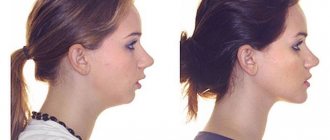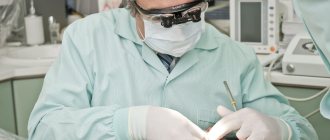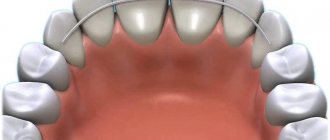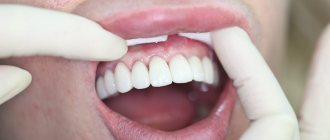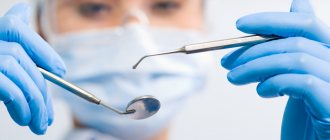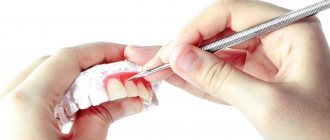To avoid having to resort to various types of prosthetics or implantation for as long as possible, experts recommend visiting a dental office for preventive purposes and treating caries and other dental diseases in a timely manner. In addition to these rules, oral hygiene is very important. Let's look at the dentist's general recommendations that will help you preserve your dental health for many years.
How to brush your teeth correctly
The most important rule is to maintain the duration of cleaning. On average, the manipulation should last 3 minutes, do not forget about the inner surface of the teeth. The brush must be guided from the gums to the edge of the tooth at a right angle; if you brush otherwise, you risk introducing bacteria and germs under the gum, as a result of which various diseases develop.
Do not try to create maximum pressure on the brush, you can damage your gums and cause them to bleed, and it will not make your teeth cleaner. Try not to put pressure on the brush; dentists recommend brushing your teeth gently, barely pressing on the brush.
You need to perform hygienic procedures at least 2 times a day - morning and evening. After eating, if possible, it is better to also cleanse; if this is not possible, use a mouth rinse.
Individual teeth cleaning methods
The chewing surfaces of the upper and lower teeth are cleaned with left and right movements of the brush.
The dentition is conventionally divided into several segments: molars, premolars, front teeth on each side. Brush teeth with open dentition. The brush is positioned at an angle of 45 degrees to the tooth surface. They begin to brush their teeth from the vestibular surface of the upper jaw on the left, performing 10 sweeping movements from top to bottom with the brush, then gradually move through all other segments.
After this, the palatal surface of the upper teeth is cleaned, moving in segments from left to right, making 10 sweeping movements on each one.
On the lower jaw, teeth are brushed in the same sequence.
When cleaning the palatal and lingual surfaces of the upper and lower jaws, the brush is placed perpendicular to the dentition on the upper jaw with the handle down, on the lower jaw with the handle up.
Cleaning ends with circular movements along the vestibular surfaces, grabbing the teeth, gums and moving the brush from left to right.
Leonard method
The toothbrush is placed perpendicular to the vertical surface of the teeth, making vertical movements in the direction from the gums to the crown of the tooth. The vestibular surfaces are cleaned with the dentition closed, the palatal surfaces with the dentition not closed, and the chewing surfaces with back and forth movements. The method avoids damage to the gums.
Bass method
The bristles of the brush should be at an angle of 45 degrees to the axis of the tooth, with their ends partially penetrating into the gingival groove and interdental spaces. When cleaning, vibrating movements are made back and forth. The method allows you to thoroughly clean the cervical area of the molars.
Fones method
With closed dentition, the bristles of the brushes, located perpendicular to the vestibular surface of the teeth, perform circular movements. The lingual and chewing surfaces are cleaned with the same movements with open dentition alternately on the upper and lower jaws.
Brush rotation method
The bristles of the brush are placed on the mucous membrane of the gums. Using rotating movements, move the brush towards the crown of the tooth. These movements are repeated 10-12 times in each segment of the dentition.
Reite method
The bristles of the brush are installed parallel to the axis of the tooth, with their free ends adjacent to the gingival margin. When cleaning, perform rolling movements back and forth.
Smith-Bell method
The movements of the brush follow the path of food during chewing. The brush is placed perpendicular to the chewing surface and in this position, with gentle pressure and rotation, is advanced to the gum.
Charter Method
Used both for cleaning teeth and for massaging gums. The toothbrush is positioned so that the bristles are at an angle of 45 degrees to the gum line. The ends of the bristles are directed towards the cutting edge of the tooth. Without removing the bristles, maintaining their inclined position, perform soft shaking or circular movements, during which the bristles penetrate into the interdental spaces.
Stillman method
The toothbrush is positioned so that the ends of the bristles lie partly on the gum and partly on the cervical area of the tooth. Apply pressure on the gingival margin until the gums become noticeably anemic, performing a slight rotational movement with the brush. The movement is stopped to restore blood flow in the gum. The lingual surfaces are cleaned in the same way. The chewing surfaces are cleaned with bristles directed perpendicular to the occlusal surface.
Which toothbrush to choose
The choice of teeth cleaning tool is limited by the stiffness of the bristles. Recommendations from dentists agree:
- If there are no problems with teeth and gums, choose hard bristles.
- For sensitive enamel, give preference to medium hardness.
- If you have gum disease, it is better to choose a soft brush.
For hygienic purposes, do not use other people’s dental devices, even if we are talking about loved ones.
When choosing an electric device, choose a model with a 90-degree rotating head, this allows you to clean out food debris even in hard-to-reach places.
Is tooth decay contagious?
This question may seem strange to many, but patients often ask dentists this question. To some extent, caries is a “contagious” disease, since its appearance is caused by pathogenic microflora, which is also transmitted by contact. It follows that it is possible to become infected with caries.
But the very presence of pathogenic microflora is not a 100% sign of the activity of carious bacteria. Every patient has pathogenic microflora in the oral cavity, but caries as a result of poor hygiene does not. Therefore, returning to the question of whether caries is contagious, the correct answer is no. But are the pathogenic bacteria that cause it transmitted? Yes.
Recommendations for caring for braces and aligners
When wearing braces, in addition to standard hygiene procedures, you need to purchase a special device - a dental brush, which allows you to clean the space between the braces and tooth enamel.
Caring for your mouthguards varies slightly; they should be removed from your mouth when eating food to avoid damage. When brushing your teeth, the aligners are also removed and stored in a special container.
Let's consider a few more recommendations from dentists:
- After taking any food or drink, the mouthguard should be rinsed with warm water.
- The structure is cleaned twice a day using a soft brush and gel paste.
- Do not forget to carry out hygienic manipulations with the teeth themselves.
Restore healthy color to gums
To eliminate gum inflammation, photodynamic therapy will be required. The gel is applied to the gums and after 10 minutes is illuminated with a laser beam. Oxygen is released into the tissue from the gel, which quickly eliminates inflamed cells. As a result, the gums become healthy, acquire a pleasant pale pink color, bleeding disappears, and increased sensitivity decreases.
Contraindications
No. This treatment method is one of the safest in dentistry.
pros
Painless because the gums are not subject to mechanical damage.
Minuses
No. This is a simple procedure that does not damage the gums, does not cause pain, and does not require the use of antibiotics or other medications.
Dentists' advice after caries treatment
Treatment of caries involves applying a filling. To avoid disturbing the healed space, follow these guidelines:
- Avoid eating and drinking for 2 hours.
- Teeth brushing is carried out as usual without any changes.
- Limiting solid food for a day.
- For the first two weeks, avoid chewing gum so that the installed filling can fully take root.
If after treatment you are still bothered by toothache, you should visit a dentist for an in-person examination of the oral cavity.
Carry out artistic restoration of teeth
If there are chips and cracks, the interdental spaces are enlarged, and the teeth themselves are not pleasing with either color or shape, artistic restoration will help. It will correct the shape and color of teeth, hide old unaesthetic fillings, stains, chips and cracks in enamel. Sometimes before the procedure, caries is treated and old fillings are replaced.
Contraindications
- Bruxism is teeth grinding during sleep.
- Malocclusion or missing chewing teeth.
- Extensive tooth decay.
- Metal or metal-ceramic crowns opposite those teeth that the patient wanted to restore.
pros
If there is no caries, the teeth do not require grinding or any drilling, and the procedure itself is carried out in 1-2 visits to the doctor. The result is practically indistinguishable from the natural appearance of teeth.
Minuses
This procedure is not suitable for everyone due to a significant list of contraindications.
Dentist's recommendations after tooth extraction
If for some reason you have a tooth removed, dentists give the following recommendations:
- If a high temperature occurs within 24 hours after removal, this may be a signal of the development of inflammation. In this case, you need to immediately see a dentist.
- During the first two days from the moment of medical intervention, take painkillers, anti-inflammatory and other medications as prescribed by the doctor.
- Avoid taking a hot bath for two days and limit physical activity.
- Avoid alcoholic drinks and smoking for at least several days.
- Rinse the mouth with antiseptic solutions (as prescribed by a doctor).
- Brush your teeth carefully with a soft brush, it is very important not to damage the injured area.
- Do not eat for 3 hours, then start with warm ground food or puree.
- Try not to touch the tooth socket with your tongue.
Is it true that wisdom teeth must be removed?
Of course not, if wisdom teeth do not bother you, they erupt smoothly and participate in chewing painlessly, there is no reason to remove them. However, the opposite situation is an indication for removal.
Caring for your teeth after whitening
In order to maintain the whitening effect and consolidate the result, dentists give some recommendations:
- For the first two days after the procedure, do not drink black tea, coffee, or wine. Coloring products are prohibited: beets, carrots, etc.
- Do not smoke for two days, avoid alcohol.
- Perform high-quality hygienic procedures (brushing teeth, using mouthwash, irrigator, dental floss).
Unfortunately, any whitening only gives temporary results. To ensure you always have a dazzling smile, dentists recommend professional cleanings at least twice a year.
Why does tooth mobility occur?
Teeth have a natural “shock absorber”, violations of which are the main cause of looseness and loss. Pathological tooth mobility is most often a problem for elderly patients. Tooth mobility indicates a disruption in the connection between gum tissue and bone, which in most cases is a consequence of jaw injury or diseases such as periodontitis and periodontitis. Other factors of pathological tooth mobility include deep bite, stress, smoking, heavy chewing load, and thyroid disease.
After removing tartar and plaque from teeth
At the end of the procedure, dentists recommend not to eat or drink for the first 2 hours, as in some cases the gums may bleed a little and the sensitivity of the teeth to cold or hot may increase. Over the next 24 hours, try to eat food that has been warmed to room temperature.
Be sure to ask your dentist what recommendations for brushing your teeth he will recommend for you and which groups of teeth to especially pay attention to when brushing. Also tell the doctor what bad habits you have and your food preferences, depending on which the specialist will recommend hygiene products to you; this should be done individually and not rely on the examples of other people.
A preventive examination after cleaning should be carried out only after 3 months to check for the formation of plaque, tartar and the effectiveness of the recommendations being followed.
Whiten teeth at home
If you don't have time to visit the dentist or you can't afford professional procedures, you can do whitening at home. But it’s still up to the doctor to select a home whitening system.
Such systems most often consist of a whitening composition and a tray, which is filled with it and placed on the teeth. You either wear them every day for 15-20 minutes or leave them on overnight.
Contraindications
- Age up to 16 years.
- Pregnancy and breastfeeding period.
- Mobility of teeth and exposure of their roots.
- Gum diseases.
- Allergy to hydrogen peroxide or urea.
pros
- Convenience: the procedure is performed at home, no need to travel to the doctor.
- Lower price compared to professional whitening.
Minuses
The duration of the course (from a week to a month) and the effect is much less striking than from a professional procedure.
Recommendations from dentists after prosthetics and implantation
To extend the life of your dentures, follow these requirements:
- Don't chew gum.
- Cleaning nuts with teeth and eating too hard food is strictly prohibited.
- If the denture is removable, remove it at night and thoroughly brush your teeth first, then the denture.
- Buy a special liquid for storing the prosthesis. During the rest period, the structure is placed in a container with liquid, this will help preserve its properties and not disturb its shape.
After implantation, the following recommendations must be followed:
- Immediately after surgery, apply ice to your cheek to reduce swelling.
- For the first three days, take non-steroidal anti-inflammatory drugs.
- You cannot play sports or lift weights for two days.
- Food is allowed to be consumed after 3 hours. At first, the dishes should be ground into a paste, liquid and warm.
- In the future, cleaning artificial teeth on an implant will be no different from standard hygiene procedures.
- Every 3 months you need to visit the clinic for an examination, since the implant is not able to sense the inflammation around it, and in order to identify such lesions, a preventive examination by the dentist is required.
Top most frequently asked questions to pediatric dentists and orthodontists:
At what age should a child be shown to the dentist for the first time?
If a baby develops strong, white teeth one after another, starting from 6-8 months, then the child should be brought to the pediatric dentist at 2 years of age.
To be examined by an orthodontist at 4-5 years of age.
Why treat baby teeth?
Any tooth affected by caries is a source of chronic infection, which has a negative effect on the entire body. This chronic source of infection must be removed as soon as possible. How? The best way, if you think about the future, is to cure the tooth. The fastest way is to remove the causative tooth. If you treat a baby tooth, it will save space for the future permanent tooth and continue to take part in chewing. If a tooth is removed, there will be very little or no space left for a permanent tooth. When changing teeth, the permanent tooth will erupt as a “second row”, causing malocclusion.
If a doctor removes a baby tooth, won’t the permanent one immediately erupt in its place?
The permanent tooth will erupt when its time comes. Nature has set a strictly defined time for each tooth to appear in the oral cavity. Removing the milk precursor can speed up the process quite a bit.
Why are children's temporary prophylactic dentures made before the eruption of a permanent tooth?
If a baby tooth still had to be removed because it was too late to treat it, then you should definitely consult with an orthodontist. Nature does not tolerate emptiness and very quickly this emptiness, which formed after tooth extraction, turns into a gap due to the movement of neighboring teeth and there is simply no room left for the future permanent tooth in the dentition.
If after the removal of a baby tooth there is 1 year or more left before the permanent tooth erupts, then a plastic tooth is made that will save space for the permanent tooth. This is a children's prosthetic prosthesis.
Are there really teeth that come out immediately permanent, without milk predecessors?
Yes, everyone knows the sixth, seventh and eighth (“wisdom”) teeth, if you count from the first central tooth in each direction. Immediately permanent, without milk precursors, the following appear: the 6th tooth (at 5-6 years), the 7th (at 11-12 years), and the wisdom tooth after 16 years.
At what age is it most effective to install braces?
The ideal age for installing braces is 9-11 years old. At this age, due to the growth of the jaw, the absence of the 7th teeth and the opportunity to teach the child to take good care of the braces system, the orthodontist has a good chance of completing the treatment “without tooth extraction,” straightening the teeth and even completely correcting the bite. Also, treatment at this age has the most favorable prognosis regarding the stability of the result obtained.
What to do if a child has “weak” enamel and uneven teeth?
If the situation is critical, the bite is severely disturbed, or the child does not smile due to crooked teeth, and the enamel is significantly weakened, we suggest installing a brace system on the tongue side. But not a classic lingual brace system, which will constantly come off for a child and impair diction, but an INCOGNITO brace system with wide bases, individually manufactured for each of your child’s teeth in a laboratory in Germany.
Fissure sealing – what is actually being sealed?
Many parents have a negative attitude towards this procedure, believing that caries occurs under the sealant (special varnish). Given the technology, this is not the case. After cleaning the tooth with a special paste using ultrasound, the doctor applies a thin layer of fluoride varnish, which smoothes out the deep anatomical pits and grooves (fissures) on the tooth. If sealing is not done, then over time an invisible white coating accumulates in the fissures, containing microorganisms that, in the course of their vital activity, release acids and the tooth enamel begins to gradually dissolve, caries appears in the “white spot” stage, which is not visible to the eye. And when the coloring of this caries with pigments appears and it becomes noticeable, the caries already affects the entire thickness of the enamel. The sooner you contact a pediatric dentist, the greater the chance that there is no caries in the fissure in the form of a “white spot.” The doctor can easily check this by staining the chewing surface of the tooth with a caries marker before sealing.
What does it mean if all your teeth have been replaced, but one or two baby teeth still won’t fall out?
This means that the permanent tooth is “stuck” somewhere in the bone tissue and needs to be pulled into place. There may be another situation - the germ of a permanent tooth has not formed. In both cases, you should definitely consult an orthodontist.
If an X-ray of a 12-year-old child does not show the germ of a permanent tooth, can it appear later?
No, he can not. If the tooth germ is absent on the x-ray, and therefore in the bone tissue, it will never appear again and this permanent tooth will be absent from the oral cavity. The exception is wisdom teeth.
When and where to “cut” the frenulum, in the maternity hospital or in dentistry?
In the maternity hospital, the frenulum of the tongue is cut when the child cannot perform sucking movements due to the low mobility of the tongue, which is restrained by this very frenulum.
The frenulums of the upper and lower lips, in the case of a gap between the central teeth (diastema), are trimmed (in these cases, it would be more correct to say frenuloplasty) not earlier than the permanent incisors, second from the center, begin to erupt. Such plastic surgery can be performed correctly by a doctor who knows a special technique, which subsequently helps to close the diastema. Plastic surgery of the frenulum of the upper and lower lips is done only in the direction and under the supervision of an orthodontist, otherwise the diastema may persist.
What does it mean if a child has snow-white spots and stripes on his permanent teeth that were not there before?
This means that the child is not cleaning the surface of the tooth enamel properly. This may be a lack of knowledge of teeth brushing techniques or a toothbrush that is too soft. Or – lack of regular teeth brushing as such. A thin, dense layer of plaque that has accumulated over weeks and months on the surface of the tooth dissolves the enamel and it begins to turn white (demineralize).
Why wear trainers and plates when you can get braces right away?
Trainers, like plates, are effective at a certain age as the child grows. It is at this age that jaw growth can be directed in the desired direction, and the braces system can be installed early. Braces are installed at a later age to completely straighten the teeth.
Why do children need to be treated by a special dentist – a pediatric dentist?
Milk teeth are very different from permanent teeth, but their main feature is the location of the “nerve” close to the surface of the tooth, absorbable roots and the proximity of the permanent tooth germ. Children's permanent teeth also have a number of features, the most important of which are immature enamel and developing (growing) roots. Only a dentist with special education knows how to treat children’s teeth.
What to do if the baby tooth has not yet fallen out, but the permanent one is trying to erupt nearby?
It is necessary to contact a pediatric dentist as soon as possible to remove a baby tooth to make room for a permanent tooth. If a baby tooth is removed on time, there is a chance that the permanent tooth will erupt smoothly.
Is it normal that at 5–7 years old a child develops gaps between his baby teeth, which were previously tightly spaced?
This is how nature intended. Before changing teeth, the child’s jaws begin to grow, the size of the baby teeth does not change, and this contributes to the appearance of gaps that will be needed to accommodate future permanent teeth.
If gaps do not appear at this age, it means something has gone wrong and you should consult an orthodontist.
How to protect yourself from periodontitis?
To avoid this disease, read the recommendations of dentists:
- Buy an irrigator - a great thing that, with the help of a powerful stream of water, cleans out food debris and destroys pathogenic microflora.
- Flossing will help remove plaque and food from between your teeth.
- Change the brush once every 2 months, and after each cleaning, pour boiling water over it.
- Using an irrigator, massage the gums, which is the most effective preventive measure against the development of periodontitis.
- If you don’t have an irrigator, perform a manual massage using your fingertips.
Return your gums to their beautiful shape
If your gums have receded due to periodontitis or periodontal disease, and you want to prevent the development of this process, you can turn to mesotherapy with hyaluronic acid. This procedure ensures that the gums will neither recede nor atrophy due to the increased supply of nutrients. Mesotherapy is carried out once every 6–12 months and does not take much time.
Contraindications
- Low blood clotting.
- Presence of cancer.
pros
- Prevention of gum disease.
- Elimination of bleeding.
- Acceleration of tissue recovery.
Minuses
Possible allergy to hyaluronic acid.
How to get rid of bad breath?
Bad breath can occur for several reasons, the first being poor oral hygiene. You need to brush not only your teeth, but also your tongue, the inside of your cheek, this is where a large number of pathogenic microorganisms accumulate, which lead to an unpleasant odor.
Dentists' recommendations against bad breath:
- Buy an antibacterial mouthwash, this will help eliminate the odor;
- Eat fresh fruit in the morning, preferably citrus fruits. The acidic environment actively fights bacteria and removes unpleasant odors;
- At night, do not eat fatty foods, brush your teeth before going to bed;
- After eating, you are allowed to chew gum for a few minutes;
- If no measures help, check your stomach; often putrid breath is a symptom of gastrointestinal disease.
Take care of your oral health and your teeth will delight you with an impeccably beautiful smile for a long time! If you experience any pain or problems with the oral cavity, do not delay going to the dentist!
Install a “quick” crown
If a piece of a tooth has chipped or the enamel has lost its natural color, and the tooth stands out among its neighbors, then installing a ceramic crown—a prosthesis that covers the tooth on all sides—will help solve these problems.
The crown is made from a solid ceramic bar or veneer (a thin plate that the doctor places on the front surface of the tooth) and is installed in just one visit to the dentist.
The doctor will scan your teeth, and the computer will make a crown or veneer in 1–1.5 hours from ceramics or porcelain. After which the dentist will install the finished crown on the tooth.
Contraindications
- Bruxism.
- Mobility of teeth.
pros
Long-term restoration of the tooth's shape, after which no one will guess that there is a crown or veneer on the tooth.
Minuses
Relatively high price.
Dentist Patient Reminder
When and how to brush your teeth during braces treatment
When to clean? You should brush your teeth in front of a mirror after each meal for at least 10 minutes. Use for this: Ortho brush, single-tuft brush. The Ortho toothbrush has a V-shaped groove along the central part of the bristles, which follows the contours of the braces system.
A single-tuft brush cleans braces and adjacent surfaces, teeth along the gums, and spaces between teeth.
Dental brushes are ideal for cleaning spaces under the arch and between teeth.
When you leave home, we recommend that you have toothpaste, brushes and a case for them with you.
How to clean? Start with the upper jaw. First, use an Ortho brush to clean the outer surface of the teeth on which the braces are attached, making horizontal movements along the entire arc of the braces system, then move on to the lower jaw.
Using a single-tuft brush, thoroughly clean each bracket and the surrounding areas, clean the gingival sulcus and parts of the teeth near the gum.
After this, use brushes to clean the space under the arch and between the teeth.
Continue brushing as usual when there are no braces on the teeth. Hold the brush at an angle of 45° to the gum and brush two teeth simultaneously 10 times with scraping movements. Repeat this over the next two teeth. The same applies to the inner surface (lingual and palatal) of teeth. Brush the chewing surfaces of your teeth.
Finish the brushing with superfloss, pulling it between the teeth and cleaning the sides. Rinse your mouth with warm water and a fluoride mouthwash to strengthen your tooth enamel.
It is recommended to select pastes with a high fluoride content, which increases the resistance of enamel to caries.
Treatment of baby teeth in our clinic
To check the condition of your baby’s teeth and treat identified diseases, we invite you to the KANO dental clinic. Experienced doctors work here who know how to find an approach to any small patient. They master modern methods of combating complications in both baby teeth and permanent teeth that do not have formed roots. Taking into account the clinical situation, as well as the age of the child, treatment in one or several visits is possible. Our kids don’t cry, because they are not scared or in pain, but are very interested.
To make an appointment with a pediatric dentist, just call 401, or leave a request here.
Why does bleeding gums occur?
In fact, there are many reasons for bleeding gums. All of them can be classified into groups:
- general diseases of the body;
- hormonal disorders;
- the use of drugs that reduce blood clotting;
- gum diseases (gingivitis, periodontitis);
- insufficient oral hygiene;
- deficiency of folic acid, vitamins C, B12, P.
Any question can and should be asked to the dentist at the appointment; you should not be embarrassed if there is a gap in your knowledge regarding the rules of oral hygiene, the causes of diseases of the teeth and gums, and so on. The dentist will definitely fill this gap, which will help the patient avoid possible mistakes and diseases and improve dental health.
Recommendations for patients with braces
You have been fitted with a braces system... Now your teeth require special, careful care and even considerable “sacrifices” from your stomach. The owner of the braces system must carefully observe the rules of personal hygiene. And the “tools” used for this are not simple ones, but special ones - toothbrushes with a V-shaped cut in the bristles, floss and dental brushes. Your doctor will advise which of them is better, and you can buy them in pharmacies. In addition, for the entire duration of treatment, the patient must “make friends” with the hygienist in order to be constantly under control. And if orthodontic treatment is complicated by periodontal disease, observation by a periodontist is necessary.
During treatment with braces, you cannot:
- Crispy potatoes, waffles, bread, cookies - they stick to the braces so much that you can’t clean them off!
- Dryers, bagels, crackers will break the arch, tear off braces and rings!
- Caramel suckers, toffee toffees, lollipops, ice cream, nuts, chewing gum.
- Eating foods that are too cold or hot, the temperature difference can lead to the braces coming off and the properties of the orthodontic wire deteriorating.
When treated with plastic braces, you should not drink coffee, tea, or eat currant jam, because the clasps of the braces may become stained.
Remember:
- If the brace comes off, you must save it and immediately arrange an appointment with your doctor. The same applies to changing the position of a fixed orthodontic ring;
- You should not worry if you experience some discomfort or pain in the first 3-7 days after installing the braces system.
- sensations in the teeth, injury to the cheeks and lips. To make it easier to get used to braces during this period, they are sealed with soft wax;
- Visit a dental hygienist once a month for professional hygiene and fluoridation of enamel varnishes.

